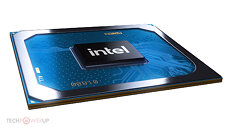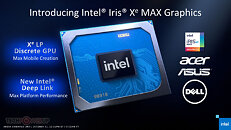Saturday, October 31st 2020

Intel Storms into 1080p Gaming and Creator Markets with Iris Xe MAX Mobile GPUs
Intel today launched its Iris Xe MAX discrete graphics processor for thin-and-light notebooks powered by 11th Gen Core "Tiger Lake" processors. Dell, Acer, and ASUS are launch partners, debuting the chip on their Inspiron 15 7000, Swift 3x, and VivoBook TP470, respectively. The Iris Xe MAX is based on the Xe LP graphics architecture, targeted at compact scale implementations of the Xe SIMD for mainstream consumer graphics. Its most interesting feature is Intel DeepLink, and a powerful media acceleration engine that includes hardware encode acceleration for popular video formats, including HEVC, which should make the Iris Xe MAX a formidable video content production solution on the move.
The Iris Xe MAX is a fully discrete GPU built on Intel's 10 nm SuperFin silicon fabrication process. It features an LPDDR4X dedicated memory interface with 4 GB of memory at 68 GB/s of bandwidth, and uses PCI-Express 4.0 x4 to talk to the processor, but those are just the physical layers. On top of these are what Intel calls Deep Link, an all encompassing hardware abstraction layer that not only enables explicit multi-GPU with the Xe LP iGPU of "Tiger Lake" processors, but also certain implicit multi-GPU functions such as fine-grained division of labor between the dGPU and iGPU to ensure that the right kind of workload is split between the two. Intel referred to this as GameDev Boost, and we detailed it in an older article.Deep Link goes beyond the 3D graphics rendering domain, and also provides augmentation of the Xe Media Multi-Format Encoders of the iGPU and dGPU to linearly scale video encoding performance. Intel claims that a Xe iGPU+dGPU combine offers more than double the encoding performance of NVENC on a GeForce RTX 2080 graphics card. All this is possible because a common software framework ties together the media encoding capabilities of the "Tiger Lake" CPU and Iris Xe MAX GPU that ensures the solution is more than the sum of its parts. Intel refers to this as Hyper Encode.Deep Link also scales up AI deep-learning performance between "Tiger Lake" processors and the Xe MAX dGPU. This is because the chip has a DLBoost DP4a accelerator. As of today, Intel has onboarded major brands in the media encoding software ecosystem to support Deep Link—Hand Brake, OBS, XSplit, Topaz Gigapixel AI, Huya, Joyy, etc., and is working with Blender, Cyberlink, Fluendo, and Magix for full support in the coming months.Under the hood, the Iris Xe MAX, as we mentioned earlier, is built on the 10 nm SuperFin process. This is a brand new piece of silicon, and not a "Tiger Lake" with its CPU component disabled, as its specs might otherwise suggest. It features 96 Xe execution units (EUs), translating to 768 programmable shaders. It also has 96 TMUs and 24 ROPs. It features an LPDDR4X memory interface, which 68 GB/s of memory bandwidth. The GPU is clocked at 1.65 GHz. It talks to "Tiger Lake" processors over a common PCI-Express 4.0 x4 bus. Notebooks with Iris Xe MAX have their iGPUs and dGPUs enabled to leverage Deep Link.Media and AI only paint half the picture, the other being gaming. Intel is taking a swing at the 1080p mainstream gaming segment with the Iris Xe MAX offering over 30 FPS (playable) in AAA games at 1080p. It trades blows with notebooks that use the NVIDIA GeForce MX450 discrete GPU. We reckon that most e-sports titles should be playable at over 45 FPS at 1080p. Over the coming months, one should expect Intel and its ISVs to invest more in Game Boost, which should increase performance further. The Xe LP architecture features DirectX 12 support, including Variable Rate Shading (tier-1).But what about other mobile platforms, and desktop, you ask? The Iris Xe MAX is debuting exclusively with thin-and-light notebooks based on 11th Gen Core "Tiger Lake" processors, but Intel has plans to develop desktop add-in cards with Iris Xe MAX GPUs sometime in the first half of 2021. We predict that if priced right, this card could sell in droves to the creator community, who could leverage the card's media encoding and AI DNN acceleration capabilities. It should also appeal to the HEDT and mission-critical workstation crowds that require discrete graphics, as they minimize their software sources.Update Nov 1st: Intel clarified that the desktop Iris Xe MAX add-in card will be sold exclusively to OEMs for pre-builts.
The complete press-deck follows.
The Iris Xe MAX is a fully discrete GPU built on Intel's 10 nm SuperFin silicon fabrication process. It features an LPDDR4X dedicated memory interface with 4 GB of memory at 68 GB/s of bandwidth, and uses PCI-Express 4.0 x4 to talk to the processor, but those are just the physical layers. On top of these are what Intel calls Deep Link, an all encompassing hardware abstraction layer that not only enables explicit multi-GPU with the Xe LP iGPU of "Tiger Lake" processors, but also certain implicit multi-GPU functions such as fine-grained division of labor between the dGPU and iGPU to ensure that the right kind of workload is split between the two. Intel referred to this as GameDev Boost, and we detailed it in an older article.Deep Link goes beyond the 3D graphics rendering domain, and also provides augmentation of the Xe Media Multi-Format Encoders of the iGPU and dGPU to linearly scale video encoding performance. Intel claims that a Xe iGPU+dGPU combine offers more than double the encoding performance of NVENC on a GeForce RTX 2080 graphics card. All this is possible because a common software framework ties together the media encoding capabilities of the "Tiger Lake" CPU and Iris Xe MAX GPU that ensures the solution is more than the sum of its parts. Intel refers to this as Hyper Encode.Deep Link also scales up AI deep-learning performance between "Tiger Lake" processors and the Xe MAX dGPU. This is because the chip has a DLBoost DP4a accelerator. As of today, Intel has onboarded major brands in the media encoding software ecosystem to support Deep Link—Hand Brake, OBS, XSplit, Topaz Gigapixel AI, Huya, Joyy, etc., and is working with Blender, Cyberlink, Fluendo, and Magix for full support in the coming months.Under the hood, the Iris Xe MAX, as we mentioned earlier, is built on the 10 nm SuperFin process. This is a brand new piece of silicon, and not a "Tiger Lake" with its CPU component disabled, as its specs might otherwise suggest. It features 96 Xe execution units (EUs), translating to 768 programmable shaders. It also has 96 TMUs and 24 ROPs. It features an LPDDR4X memory interface, which 68 GB/s of memory bandwidth. The GPU is clocked at 1.65 GHz. It talks to "Tiger Lake" processors over a common PCI-Express 4.0 x4 bus. Notebooks with Iris Xe MAX have their iGPUs and dGPUs enabled to leverage Deep Link.Media and AI only paint half the picture, the other being gaming. Intel is taking a swing at the 1080p mainstream gaming segment with the Iris Xe MAX offering over 30 FPS (playable) in AAA games at 1080p. It trades blows with notebooks that use the NVIDIA GeForce MX450 discrete GPU. We reckon that most e-sports titles should be playable at over 45 FPS at 1080p. Over the coming months, one should expect Intel and its ISVs to invest more in Game Boost, which should increase performance further. The Xe LP architecture features DirectX 12 support, including Variable Rate Shading (tier-1).But what about other mobile platforms, and desktop, you ask? The Iris Xe MAX is debuting exclusively with thin-and-light notebooks based on 11th Gen Core "Tiger Lake" processors, but Intel has plans to develop desktop add-in cards with Iris Xe MAX GPUs sometime in the first half of 2021. We predict that if priced right, this card could sell in droves to the creator community, who could leverage the card's media encoding and AI DNN acceleration capabilities. It should also appeal to the HEDT and mission-critical workstation crowds that require discrete graphics, as they minimize their software sources.Update Nov 1st: Intel clarified that the desktop Iris Xe MAX add-in card will be sold exclusively to OEMs for pre-builts.
The complete press-deck follows.



























74 Comments on Intel Storms into 1080p Gaming and Creator Markets with Iris Xe MAX Mobile GPUs
To be able to call it gaming it should be at least 60 FPS @1080p
30FPS @1080p is gaming on life support at best, you get a computer you can play older games
BUT what happens when that next gen games comes in a month and you get 20FPS in that game and it is unplayable, then you realized you wasted your money on this Intel gaming dGPU.
I'm laughin so hard, I need to part my hair just to take a dump...:roll:..:eek:..:D..:kookoo:..:clap:..:peace:
also, if it's their "Max" i wonder what is their "Min" if the "Max" only compete vs a MX450
classical Intel tho ... they need to revise their PR strategy :laugh: some slide give a very childish vibe ...
[joke]typical intel[/joke] "we are the best at that because no one did better than us at doing the best for the worst part of something!" :laugh:
take it as a joke ;)
Intel's slides are about mobile creation and integration with iGPU, gaming is mentioned less prominently.
The negative reactions are probably because nvidia and AMD are neglecting the low-mid end and people (myself included) are anxious for a competitive low end card. Intel overpromised "enthusiast" level discrete cards so we were hoping no matter how much they underdelivered, we'd at least get a respectable 100-120 or 200 dollar pricerange GPU.
Maybe we will, next year. Doesn't seem promising so far, I have to say.
So far we've gotten a look at a crap discrete GPU back in February and an iterative igpu step with Xe branding.
I'm still hoping intel gets it right, eventually, because GPU prices are ridiculous right now.
Amd have nothing in this Class, only a RX 550 and this Crap is slower than an GT 1030:laugh:
Yeah sure AMD have the APU, but the Rzyen 3 3400G is still slower than a GT 1030 (GDDR5) in Games:slap:Yeah Gaming is exclusive for the Great 1000$ Card buyers, i play atm on a massive OC GT 710 GDDR5 my Games like WoW and FFXIV runs very well with it.
1) This essentially looks a lot like GPU-coprocessor (thanks to Anandtech for a metaphor), which is good, of course. There is a question of cost and software which uses it (which I do expect to grow).
2) One thing I'm passionately hating Intel for is their active taking part in HSA downfall, and *now* they are implementing it themselves. Hypocrisy of the highest possible level (oh, and people on Anandtech missed it completely). And their solution is proprietary, as I understand. Disgusting.
On the other hand, I highly doubt that AMD and NVIDIA will have troubles making competitive products (on die or separate), and open standard would be nice (one already exists, *coughs*).
I'm familiar with the asymmetric Crossfire capability; but it never quite lived up to its potential at the time. I was thinking Intel had beaten AMD to a modern implementation of the same concept with this announcement, but it turns out that was just misleading and not fully usable that way; rather, it's only usable in content creation rather than all the time.